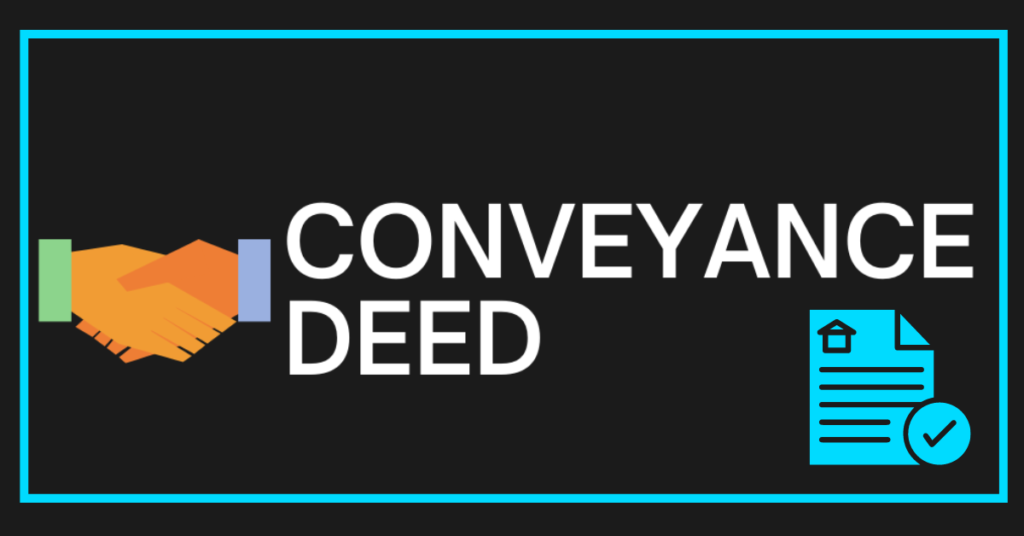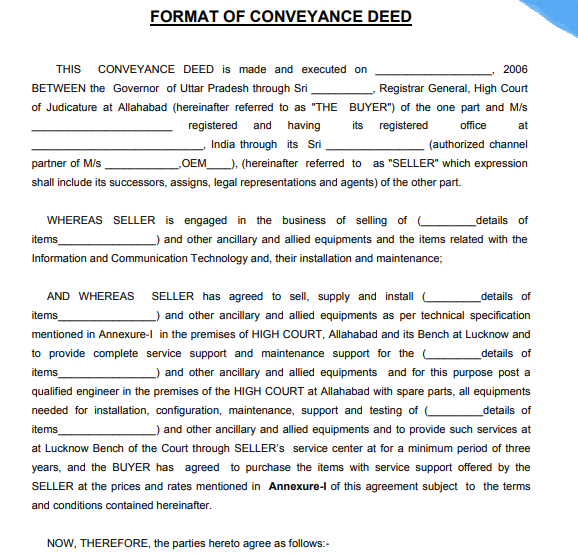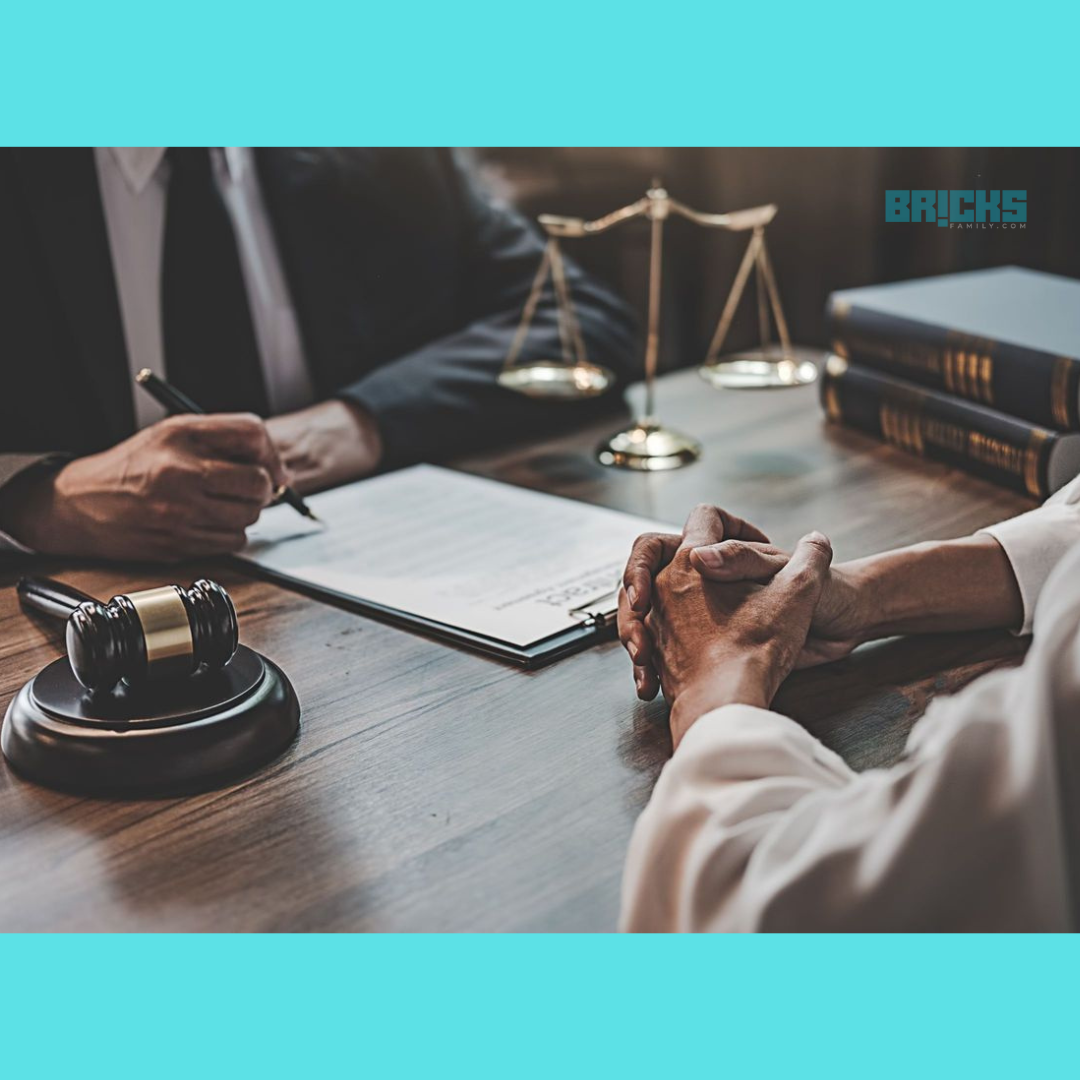Lets understand What is a Conveyance Deed & Why Conveyance Deed Important?
When you buy or sell a home, you need to fill out a lot of paperwork. Some documents and terms may be familiar to you, while others may be new to you. Today, we talked about a document called a conveyance deed in detail. Transferring property rights to someone else is called conveyance, while a deed is a written document. Let us understand in detail.
Meaning of Conveyance Deed
A conveyance deed is a legal document that is used to change the ownership of a piece of property from one person to another. This can be done as a gift, an exchange, a lease, a mortgage, etc. A conveyance deed can also be called a gift deed, mortgage deed, lease deed, or sale deed.

What’s the difference between sale deed and conveyance deed?
The term “conveyance deed” refers to any type of property transfer in favor of the buyer, such as a gift, mortgage, lease, exchange, etc. A sale deed is a legal document that transfers ownership of a property when it is sold. All sale deeds are conveyance deeds, but not all conveyance deeds are sale deeds. The sale deed is a conveyance deed. All deeds that transfer property rights are conveyance deeds.
What should a conveyance deed include?
The following should be in a conveyance deed:
- defined the property’s borders
- Power to appoint (if any)
- Chain of title showing that the current seller has all legal rights
How the property will be given to the buyer is explained.
A note saying that ownership of a piece of property has been received. Signatures from both parties, which show that they are the buyer and seller Other conditions and terms related to the property transfer Things to make sure of before signing a conveyance deed The seller must make it clear that there are no legal claims on the property.
Before the deed is signed on a property with a mortgage, the mortgage must be paid off. A local sub-office registrar’s is where buyers can check these details. The conveyance deed must say exactly when the buyer will be able to take possession of the property.
All of the original property documents should be turned in to the local sub-registrar within four months of the deed being signed. At the time of registration, at least two witnesses have to sign the conveyance deed.
Types of Transfer Deed
- The different kinds of conveyance deed are as follows:
- Freehold Property Conveyance Deed: This type of conveyance deed is made when a property is turned into a freehold property by an authority.
- Conveyance deed for leasehold property: The leasehold property deed of conveyance outlines leasehold ownership of the property. A leasehold property is one where the owner can do anything inside the walls, but nothing can be done to the outside walls.
- Mortgage Property Conveyance Deed: A mortgage property conveyance deed is for property that is mortgaged.
What does a Conveyance Deed do?
As we’ve talked about, that conveyance deed is a legal document that is used to buy or sell a house. If you have this document, you will not be a victim of fraud. When you go to buy a house, you have to ask for a copy of the conveyance deed.
Format of the Deed of Transfer Here’s how a conveyance deed looks:

Format of Conveyance Deed
Source: Allahabad High Court
How do I go about getting a conveyance deed?
A conveyance deed is written on non-judicial stamp paper of the right value and registered at the sub-registrar office closest to the property. Post-registration, stamp duty, and registration fee should be paid by the buyer. Stamp duty and registration fees are different in every state.
Needed documents for conveyance deed
List of documents needed for a transfer deed
- Registered Agreement with the seller to sell a property
- Changes to mutations/Property card
- The Revenue Department’s location plan and survey plan
- Layout and building plans that have been approved by the right authority
- Certificates like the Commencement Certificate, Completion Certificate, Occupancy Certificate (if not available) and Architect Certificate
- A full list of who owns what
- Payment receipt for stamp duty
- If the seller signs the contract, you need a power of attorney or a development agreement.
- Draft transfer deed
- Why a conveyance deed is important
- If there is a dispute, the conveyance deed can be used as proof.
- It proves that there are no problems with the property.
- Identifies who owns the land.
- Gives the buyer the legal rights to the property
What happens if the Transfer Deed gets lost?
If the conveyance deed is lost because of carelessness, you need to do the following:
- The police should get a FIR (First Information Report).
- A loss of conveyance deed ad can be seen in the newspaper.
- Make an affidavit and get it signed by a notary. All of the property information and FIR should be in an affidavit.
- A sub-office registrar’s is another place where you can get a certified copy of the deed. But you will have to pay some fees to get this document.
- Things to Keep in Mind About the Conveyance Deed
- A conveyance deed can be a sale deed, but not the other way around.
- The Registrations Act governs conveyance deeds, which are signed on non-judicial stamp paper.
- After both parties sign a conveyance deed, it should be registered with the sub-registrar.
- At least two people must sign a conveyance deed.
In the end, a conveyance deed is a legal document that gives the rights to a property to the person who buys it. If a conveyance deed is not made, a property purchase is not finished. The Registrations Act says that it needs to be registered with the sub-registrar. Also, the deed must be signed by two witnesses.
Also read about : Lifestyle , Financial and Legal , Polices
Similer Topics : What RERA Carpet Area Means and How is it Calculated












